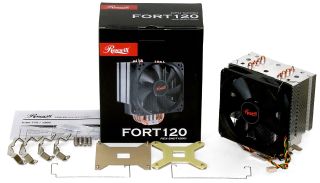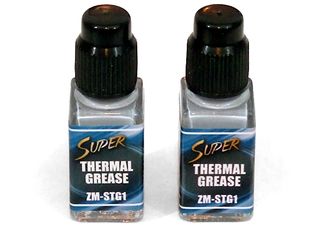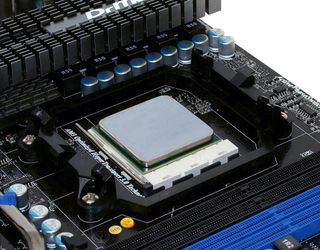Guide: Overclocking AMD And Intel CPUs On A Budget
Keeping It Cool
Cool processors clock higher and survive longer, but finding an inexpensive cooler in the preferred 120mm tower design able to support both AMD and Intel processors isn’t easy. Rosewill surprised us with a review sample that included an AMD-style clip, since its Fort 120 doesn’t advertise Socket AM2+/AM3 compatibility on the box. Readers should look forward to a review of this unit later this month.

This is the point where some die-hard overclockers might point out that, since we used top-end motherboards, we should also use a top-end liquid cooling system. But while budget overclockers might be able to find less expensive motherboards that replicates our results, the same cannot be said of liquid cooling. We wanted to provide a realistic, yet optimistic target for value-overclockers to use as a goal.
One other place we didn’t go cheap was in thermal compound selection. The Fort 120 cooler does not include enough thermal paste for multiple uses, so we instead relied on our established thermal grease choice.

Zalman’s ZM-STG1 was chosen for previous reviews based on its easy application, quick set in time, and upper-range thermal performance. Upon request, the firm supplied enough samples for each U.S. editor to have two bottles.

Thermal grease or paste fills small gaps between the processor and heat sink to provide a greater contact area. Many experienced builders swear that too heavy a layer will prevent proper sink contact, citing the lower conductivity of thermal compound compared to the aluminum or copper surface it fills, but most modern thermal materials are thin enough that heat sink pressure will squeeze out any excess. The real problem of applying too much paste is that it can make a mess of the motherboard, and its low-conductivity is still enough to potentially cause signal or voltage problems.
Stay on the Cutting Edge
Join the experts who read Tom's Hardware for the inside track on enthusiast PC tech news — and have for over 25 years. We'll send breaking news and in-depth reviews of CPUs, GPUs, AI, maker hardware and more straight to your inbox.
Current page: Keeping It Cool
Prev Page Getting Started, The Hardware Next Page More Shared Hardware-
tacoslave i like these "how to" articles but i still want to see the rest of the twkr article you promised us (quad crossfire 4890's) *sigh* a man can dream can't he?Reply -
snakeeater_za Surely people on a budget (like me) would prefer their e5200 to last longer than a 'few months or hopefully a yr to 3?' i know i will upgrade prob in a year or so, so a yr would be fine, but a few months? Pfffft. my proc vid is 1.225 and for 3.33ghz i need a vcore of 1.385 in bios which at idle is 1.36ish. So although im nowhere near 4 at least i wont suffer from electromigration and have to fork out for a new cpu! Just my 2 centsReply -
Crashman snakeeater_zaSurely people on a budget (like me) would prefer their e5200 to last longer than a 'few months or hopefully a yr to 3?' i know i will upgrade prob in a year or so, so a yr would be fine, but a few months? Pfffft. my proc vid is 1.225 and for 3.33ghz i need a vcore of 1.385 in bios which at idle is 1.36ish. So although im nowhere near 4 at least i wont suffer from electromigration and have to fork out for a new cpu! Just my 2 centsReply
It's all a game of averages. Tom's Hardware hasn't accidently killed a processor by overclocking it in a while, though I'm sure a couple editors have intentionally done so to find the voltage limit. The problem is, once again, you can only look at averages.
3 months continuous use at 1.45 volts caused an E8500 to lose its OC stability. It had to be clocked down to become stable again, and lost much of its voltage tolerance. It wasn't destroyed however.
1.40 volts should be significantly safer than 1.45 volts, but until a few people report on how long their cores lasted at 1.40 volts its impossible to tell "how much safer", that is, how much longer it will last. All that's known is that it should last "significantly" longer, but whether that's 4 months (33% longer) or 30 months (10x longer) is the unanswerable question. -
astrodudepsu Good show mate.Reply
I would have liked to see combined charts as a conclusion but that's a minor criticism.
I'm just wondering what the 'next-gen' E5200 (i.e. the intel people's OC'er) will turn out to be? Some flavor of i5 I assume, but who knows. -
JeanLuc LinkReply
"Intel’s value-priced Core 2 Quad Q8200 uses two of the same processor dice as the Pentium E5200....."
I don't know why you choose the Q8200 it's a notoriously bad overclocking chip, if you wanted a budget Intel Quad core that had room for overclocking you should have bought the Q6700/Q6600. -
”Motherboard MSI P45 Diamond LGA-1366, P45/ICH10R, BIOS 1.5 (10/10/2009)”Reply
MSI P45 Diamond is not LGA1366, but LGA775. LGA1366 is for Core i7 processors only, LGA1156 is for Core i5 and i7 (only dual channel DDR3-1333/1066). LGA775 is the old socket, for Celeron D, Celeron 4xx, Pentium Dual Core, Pentium 4, Core 2 Duo, Core 2 Quad. -
da bahstid No games? Like...none at all? Does anybody even overclock for reasons other than games?Reply
Otherwise, pretty good article. Though perhaps a better choice for the Intel quad would have been a 9550...I thought they were under $250 by now. Same time, I guess the Q8200 does seem to be a more difficult overclocker...Intel may have intended this to be the case so as not to gut sales of their Q9000 series. And readers may as well know before jumping on a Q8200 thinking it'll overclock like an E5200.
Most Popular


